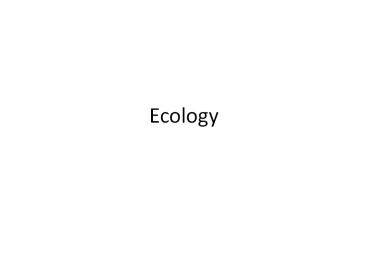Ecology - PowerPoint PPT Presentation
1 / 37
Title:
Ecology
Description:
Ecology Introduced Species Starlings and house sparrows are introduced species from Europe. They competed with the bluebird population drastically reducing its ... – PowerPoint PPT presentation
Number of Views:90
Avg rating:3.0/5.0
Title: Ecology
1
Ecology
2
Ecology
- Ecology is the scientific study of the
interactions among organisms and between
organisms and their environments.
3
Habitats
- The place where an organism lives and that
provides the things the organism needs is called
its habitat! - Food, water, and shelter.
- Biotic Factors The living parts of an
ecosystem. - Animals, plants, fungi, bacteria.
- Abiotic Factors The nonliving parts of an
ecosystem. - Water, Sunlight, Oxygen, Temperature, and soil.
4
Organism
- The smallest unit of ecological study.
- Wildebeest
5
Populations
- A population is a group of individual organisms
of the same species living in a particular area.
- Herd of Wildebeest
6
Exponential Growth
- Occurs when the population multiplies by a
constant factor at constant time intervals.
7
Limiting Factors
- A factor that restricts the growth of a
population. - Space
- Food availability
- Disease
8
Community
- All of the organisms inhabiting a particular area
make up a community.
9
Ecosystem and Biosphere
- An ecosystem includes the abiotic and biotic
factors in an area. - The biosphere is the sum of all Earths
ecosystems.
10
(No Transcript)
11
How do organisms get energy?
- Every organism requires energy to carry out life
processes such as growing, moving, and
reproducing. - Producers (autotroph) synthesize their own food
through the process of photosynthesis. - Consumers (heterotrophs) obtain their energy by
eating other organisms. - Decomposers -
12
Types of Consumers
- Herbivore eats plants.
- Omnivore eats plants and animals.
- Carnivore eats animals.
13
Food Chains
- The pathway of energy transfer form one organism
to another is called a food chain. - What would happen if one organism is overhunted
and removed from the food chain? - What is the source of all energy?
14
Food Web
- A pattern of feeding represented by
interconnected and branching food - chains is called a food web.
15
Energy Pyramid
- Emphasizes the energy loss from one organism to
the next in a food chain. Only 10 is passed on
to the next level, the rest is lost to the
ecosystem in the form of heat.
16
Types of Relationships among species!
- Predation an interaction in which one organism
eats another. There are two individuals that
participate. - Predator and Prey
- Fox is a predator and the rabbit is the prey.
17
Symbiotic Relationships
- A symbiotic relationship is a close interaction
between species in which one of the species lives
in or on the other. - Parasitism one benefits and the other is
harmed. - Mutualism both species benefit
- Commensalism one benefits and the other is
neither helped or harmed
18
(No Transcript)
19
Ecological Succession
- The process of community change is called
ecological succession. - What would happen if you left the field behind
Heritage uncut for a couple of years?
20
Primary Succession
- When a community arises in a lifeless area that
has no soil. - Pioneer species are the first to colonize barren
rock. - Climax community takes hold several hundred or
thousand years later. The forest has grown to
its full capacity.
21
Secondary Succession
- When a disturbance damages an existing community
but leaves the soil intact, the change that
follows is called secondary succession. - Fires
- Land cleared for farming, then abandoned.
22
The Carbon and Oxygen Cycle
- Carbon starts its cycle in the atmosphere as
Carbon Dioxide. - Plants take in the carbon dioxide and make
organic compounds known as glucose. - That glucose gets passed on to consumers through
the food chain. - They then release carbon dioxide back into the
atmosphere through the process of cellular
respiration.
23
Human Activities can alter ecosystems!
24
(No Transcript)
25
Population Growth
- As the human population continues to grow, the
environment will be negatively impacted by the
following. - Habitat destruction
- Deforestation
- Air Pollution
- Acid Rain
- Water pollution
- Global Warming
- Introduced Species
- Reduced Biodiversity
- Overexploitation
26
Deforestation
- The clearing of forest for agriculture, lumber,
and other uses also affects the carbon cycle by
eliminating plants that absorb CO2 for
photosynthesis.
27
(No Transcript)
28
Alternatives to Clear cutting
- Dont cut down every single tree!!!!!!
- Selective Cutting
29
Greenhouse Effect
- They process by which atmospheric gases trap
heat. - Greenhouses trap heat.
30
Global Warming
- Effects of Global warming
- Rising sea levels
- Large effects on weather
- Loss of Species
- The overall rise in Earths average temperature.
- Caused by increasing carbon levels in the
atmosphere. - What causes increased carbon levels in the
atmosphere? - Deforestation
- Burning of Fossil Fuels
31
(No Transcript)
32
Acid Rain
- Precipitation that carries acid to the Earths
surface. - Smokestacks and automobile exhaust pipes release
nitrogen and sulfur compounds into the
atmosphere. They then combine with water and
form acid rain. - Can lower pH of soil and aquatic ecosystems
causing species to become extinct.
- Acid Rain
33
Water and Air Pollution
- Burning Fossil Fuels Releases chemicals into
the atmosphere. - Fertilizers end up in water supplies.
34
Introduced Species
- Starlings and house sparrows are introduced
species from Europe. They competed with the
bluebird population drastically reducing its
population.
35
Snakeheads
- Snakeheads are very aggressive and are
outcompeting all native fish populations.
Examples include Bass, Pickerel,
36
Overexploitation
- The practice of overhunting.
- Elephants were hunted for their tusks
37
What can Humans do to reduce our negative impact
on the environment?
- Selective cutting
- Make our homes more energy efficient
- Use cars get higher gas mileage
- Tougher regulations































